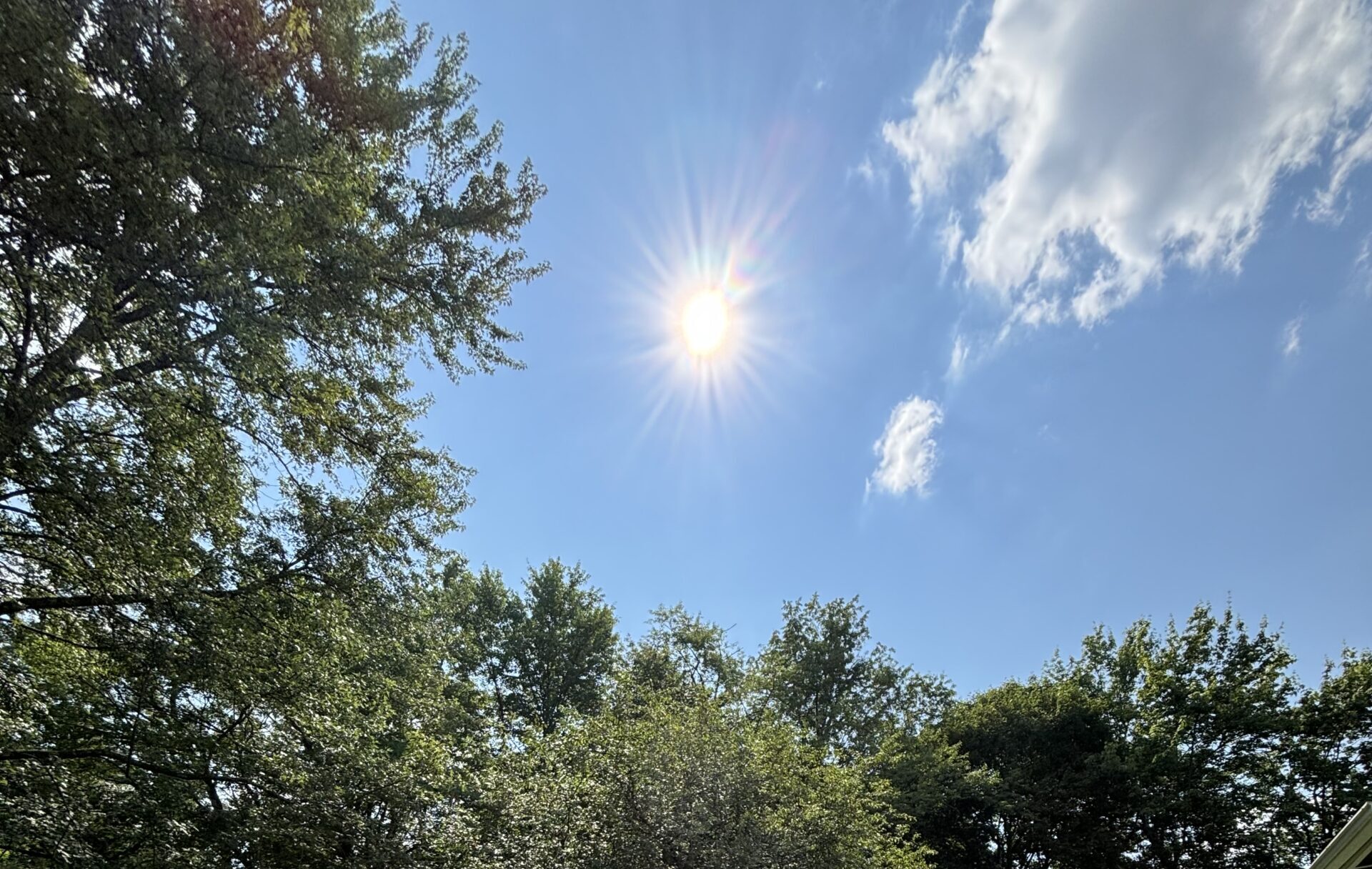The importance of sunshine!
This past winter in Ohio we had a record stretch of cloud cover. 84% of January was cloudy. It’s easy to dismiss a sunny day when it happens. Maybe you’re too busy at work. Maybe you want to be lazy and catch up on your new show. Or maybe it’s too hot outside. I know I can take sunny days for granted sometimes. I don’t realize how much the sun affects my day to day outlook until I haven’t seen it in days (or weeks). This past January I remember wondering why I felt so off. I felt tired and a little extra moody. And then I realized I couldn’t even remember the last time I saw the sun! The sun is our main source of Vitamin D, which affects many different parts of our bodies and lives. It plays a vital role in maintaining our health and well-being.
How do we get Vitamin D from the sun?
UV radiation, specifically UVB rays, from the sun triggers Vitamin D synthesis in our bodies. When the skin absorbs UVB rays, a component within the skin is converts to pre-vitamin D3, and then vitamin D3. Vitamin D3 then converts to different forms by the liver and kidneys so our bodies can use it. Our bodies use Vitamin D3 to regulate calcium and phosphate absorption, among other things.
Rickets: the first disease from Vitamin D deficiency
If we go back to the Industrial Revolution era, many children living in cities had a disease called “rickets”. This disease caused their bones to be deformed. Due to significant air pollution as well as tall buildings and increased time inside (leading to almost no access to the sun), children with rickets were extremely deficient in Vitamin D.
Once doctors understood what was causing the bone deformities, they started prescribing UV exposure to correct the issues. If you look at the way that most of us live in the 21st century, you may identify some similarities to the Industrial Revolution era. We spend a lot of time inside looking at artificial light sources and there is a lot of air pollution in large cities. Both of these limit our time in the sun to absorb UVB rays and convert them to Vitamin D. Estimates for the United States indicate a little over 30% of people are Vitamin D deficient. Estimates for the world indicate that 50% of the population is Vitamin D deficient.
Additional possible impacts of Vitamin D deficiency
Vitamin D performs a lot of important functions in our bodies, not all of which are fully understood yet. There have been many studies showing how Vitamin D deficiency correlates with diseases. An important reminder is that correlation doesn’t always equal causation. While there are many correlations between vitamin D deficiency and various diseases as you’ll see below, some of them have not been fully proven or fully understood.
- Osteoporosis and Bone Fractures: Osteoporosis and bone fractures are primarily associated with adults as they age. This is somewhat similar to the children that developed rickets in the Industrial Revolution era. As we know, Vitamin D plays an important role in calcium absorption, which is critical for bone health. If we don’t have enough Vitamin D to properly absorb the calcium in our diets, it can negatively impact our bone structure and health and put us more at risk for these types of bone problems.
- Cancer: The next association with Vitamin D deficiency is increased risk of developing several types of cancers. The first discovery came from studies that found a correlation between living at higher latitudes (i.e. further from the equator) and the risk of being fatally diagnosed with cancer. Living at higher latitudes diminishes the body’s ability to produce Vitamin D3 due to less sunlight exposure. So one suggestion is that maybe Vitamin D deficiency is actually at the root of this correlation. A different study looked at farmers in America and Canada. This study found that southern farmers were at a higher risk for developing nonmelanoma skin cancer. However, northern and particularly Northeast farmers had the highest overall cancer mortality risk. A separate meta-analysis looked at stats for over 100 countries. This study also found a correlation between exposure to UVB rays (which triggers Vitamin D synthesis) and 15 different types of cancer diagnoses. Cancers investigated most frequently with an apparent correlation to lower Vitamin D levels were colon, prostate, and breast cancer.
- Mental Illness: Many studies have also found a link between higher latitudes (and thus, lower Vitamin D levels) and schizophrenia. Studies have also found that depression correlates with Vitamin D deficiency. The correlation with depression is so well-established that we have a specific name, Seasonal Affective Disorder (SAD), for people that live in regions with significant variations in sunlight in different seasons. Typically in seasons with low amounts of sunlight, people diagnosed with SAD will feel depression-like symptoms. In seasons with high amounts of sunlight, people diagnosed with SAD will feel minimal or hardly any depression-like symptoms.
- Immune Conditions: Some studies have found linkages between Vitamin D deficiency and the risk of developing an autoimmune condition. Specific autoimmune conditions with correlations to Vitamin D deficiency are Type 1 Diabetes, Multiple Sclerosis, and Rheumatoid Arthritis. It’s not fully understood why Vitamin D may play a role in autoimmune diseases. However, it is known that Vitamin D plays a large role in cellular level immunity so it’s been suggested that this may be related. Vitamin D may play a factor with infectious diseases like the flu as well. In northern areas there is an established flu season in the colder winter months. In southern areas the flu is more sporadic and not seasonal. As doctors in the early 1900’s were learning about Vitamin D deficiency causing rickets in children, doctors actually prescribed UV light therapy to patients with rickets. They also prescribed UV light therapy to patients who had tuberculosis or upper respiratory infections. There is a long standing history of UVB rays, and thus Vitamin D, helping us with immunity.
- Cardiovascular Diseases: Hypertension and high blood pressure are usually precursors to more serious cardiovascular issues or diseases. In multiple studies, people with hypertension were prescribed UV therapy through a tanning bed. This led to an elimination of their hypertension problem. In a similar study, an added benefit of reducing hypertension was also reducing blood pressure in patients with historic hypertension issues. Cardiovascular diseases are also significantly influenced by Type 2 diabetes and obesity. Studies have found a correlation between Vitamin D deficiency and risk of developing Type 2 diabetes. Additionally, Vitamin D is what’s called lipophilic which essentially means it’s attracted to fat. When someone is overweight or obese, it’s more difficult for them to achieve the ideal levels of circulating Vitamin D. Because of this attraction to fat, this means the Vitamin D is going to a non-ideal place in their body. To further show the impact on cardiovascular disease, one study cited that Vitamin D deficiency is correlated with not only a 50% increase in a heart attack happening, but more than a 100% increase in mortality from a heart attack.
Factors affecting Vitamin D synthesis
UVB ray absorption and Vitamin D synthesis in the body are dependent on a few factors that we will go through in more detail:
- Amount of melanin: Melanin scatters energy from UVB rays from the sun. This is how melanin helps protect your skin cells from damage from the sun. Melanin is primarily determined by genetics. The more you have, the darker pigment of your skin. As a general rule of thumb, the more melanin in your skin, the less sensitive you are to the sun. You may be able to spend a longer time outside without burning than someone with less pigmented skin. Since we need to absorb UVB rays for Vitamin D synthesis, melanin also affects our Vitamin D levels. The more melanin you have, the longer time you will need to spend in the sun to synthesize the same amount of Vitamin D as someone with less melanin.
- UV Index: The UV index is generally listed as part of the weather forecast. It will tell you how intense the sun’s UV rays will be on a given day. The UV index will change over the course of the day, usually being the most intense at mid-day. The higher the UV index, the less time you need to spend outside to get your Vitamin D.
- Amount of unprotected skin exposed to the sun: This is the amount of your skin that is exposed to the sun. Sunscreen and clothing reduce the risk of sunburns and skin cancer, but they can also reduce Vitamin D synthesis by up to 99%.
- Your age: As you get older, the precursor to Vitamin D in your body decreases. For instance, a 70 year old will produce ~75% less Vitamin D than a 20 year old given the same amount and type of sun exposure.
- Your body mass index (BMI): BMI is not necessarily the best metric of fitness or health. As mentioned earlier, the amount of excess fat on your body can significantly affect the amount of circulating Vitamin D in your body. It’s likely overweight or obese people need to spend additional time in the sun to achieve an ideal level of Vitamin D.
- How long unprotected skin is exposed to the sun: this is fairly obvious given the other points above, but if you spend more time in the sun, your body will synthesize more Vitamin D.
How much Vitamin D do you need?
The Institute of Medicine (aligned with the American Academy of Pediatrics) has recommendations on the amount of Vitamin D required. The requirement for children and adults younger than 50 years old is 200 IU of Vitamin D per day. For adults older than 50, it’s 400-600 IU of Vitamin D per day. Some experts agree that we need new recommendations at 800-1000 IU/day for all ages, but this is not an official recommendation.
From all of my research, it’s near impossible to get too much Vitamin D. I typically target the higher end of the range at 600-1000 IU/day. As I mentioned earlier, since I live in Ohio the sun is not always available for Vitamin D synthesis. I usually take 1,000 IU of a Vitamin D3 supplement 2-4 times per week, depending on the season. This helps to ensure I get my Vitamin D quota, even when I don’t see the sun for an entire week in the winter.
How much Vitamin D can you get from the sun?
So we know we should get 200-1000 IU of Vitamin D each day. What’s an IU and how do you make sure you get enough Vitamin D? IU stands for “International Unit.” This is a specific way to measure fat-soluble vitamins, but it’s a different quantity for each vitamin. The good thing is this measurement is a standard across the industry. If you’re looking in supplement form, an IU of Vitamin D is the same regardless of where you buy it.
Now I will also give you a scientific approach to how you can calculate the Vitamin D you get from the sun.
- First, think about how long it would take your skin (or your husband’s skin, children’s skin, etc.) to burn. For me, I know if I spend 45-60 minutes outside in a T-shirt and shorts mid-day in the summer I’ll probably start burning.
- Next, take 50% of the time you just estimated. For this example, it would be 23-30 minutes. This is your personal 0.5MED (50% of your Minimal Erythemal Dose).
- Next, figure out how much of you is exposed to the sun. You can divide up your body into percentages as follows – 9% for your face, 9% for each arm, 18% for each leg, and 18% each for your abdomen and back. So if I’m outside in a T-shirt and shorts with a hat on to protect my face, 54% of my body is exposed (9% x 2 for my arms and 18% x 2 for my legs).
- The rule of thumb is that spending 0.5MED outside in a bathing suit (100% exposure) equals 7000-10000 IU of Vitamin D. So for my example, if I’m spending 30 minutes (my 0.5MED) outside with 54% of my body exposed to the sun, I’ll take 54% of the 7000-10000 IU range. This means I’ll get 3780-5400 IU of Vitamin D in this example. Way above the 1000 IU I target per day!
- This calculation works for any skin type and sun exposure since you’re calculating your own personal 0.5MED.
How are you making sure you get your Vitamin D quota?
Vitamin D is so important to our health, and at least 30% of the United States population is deficient in Vitamin D. Based on what you’ve learned today, are you getting enough Vitamin D? If not, how are you planning to change up your habits to ensure your Vitamin D quota is met each day? While I have supplements to help me ensure I have enough Vitamin D, I would argue Vitamin D straight from the sun makes me feel even better. Let me know how you plan to get your Vitamin D this week!
SOURCES:
- https://www.europeanreview.org/wp/wp-content/uploads/98-112.pdf
- https://www.sciencedirect.com/science/article/pii/S0002916523235935?via%3Dihub
- https://www.ncbi.nlm.nih.gov/pmc/articles/PMC6978633/
- https://www.ncbi.nlm.nih.gov/pmc/articles/PMC5036351/
- https://www.ncbi.nlm.nih.gov/pmc/articles/PMC8709188/
- https://viridian-nutrition.com/en-us/blogs/nutrition-articles/what-does-an-iu-measure-in-vitamins
- https://www.nimh.nih.gov/health/publications/seasonal-affective-disorder









